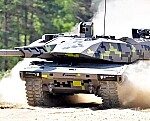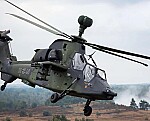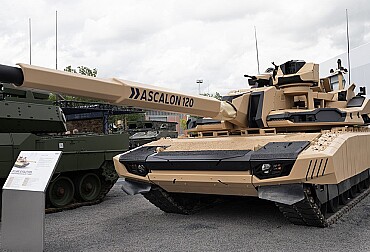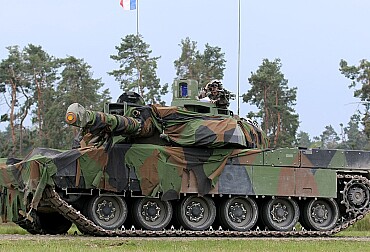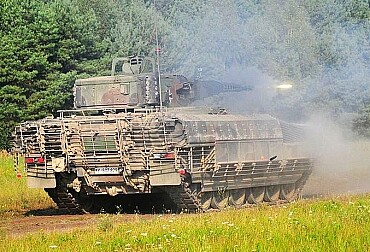Ukraine Army’s PzH 2000 need spare parts – there's a lot of wear and tear
At the beggining of October, the Renk Group has received an order for the delivery of 50 HSWL284C transmissions intended for PzH 2000 artillery systems in use the Bundeswehr, but also by other foreign customers including the Ukraine which currently deploys 42 howitzers and should receive more in the near future. The crucial questions concerns the maintenance of these effective weapons.
Delivery of the ordered transmissions was due to start as early as October, which means that the Renk Group has some stock of these components in its inventory. They are to go to German PzH 2000s, but also those used by foreign customers. The self-propelled howitzer is currently used by countries such as the Netherlands, Croatia, Lithuania, Greece, Italy, Hungary, Qatar and Ukraine. The latter country may be one of the international customers mentioned in the announcement here for several reasons.
Renk Group’s transmissions
"This order marks the continuation of our decades-long partnerships. With our ability to deliver orders at short notice, we play a key role in rapidly enhancing and maintaining the defence and allied capabilities of the Armed Forces," said Michael Masur, general manager of Vehicle Mobility Solutions at RENK.
On 6 September, at a meeting of the Ukrainian Defence Contact Group, German Defence Minister Boris Pistorius announced that Berlin would soon be delivering twelve additional PzH 2000 self-propelled howitzers to the Ukrainian army. However, the army still needs to ensure that the 28 howitzers it has already received from Germany (14 pieces), the Netherlands (8) and Italy (6) are in working order. It is a challenge due to a shortage of spare parts, which the order of new transmission may help to solve.
Ukraine currently has at least 42 PzH 2000s on its armament and eight guns from Germany serve as spare parts stock. They were received as donations from Germany, Netherlands and Italy. Further 24 howitzers are to be delivered in 2025–2027 from Bundeswehr resources, and these, arguably, are not in the best condition. In the case of 12 howitzers, of which six were already delivered, it is known that these are acquired from Qatar. They are to undergo appropriate overhauls in Germany, as it is possible that the vehicles are not in a very good technical condition, and modifications in order, among other things, to standardise them with the vehicles the Ukrainians have had so far. Thus, it is not impossible that the new transmissions will be used for the vehicles already in Ukraine, as well as those that will arrive there in the future.
Wear on the 155mm/52 tubes
Already back in summer of 2022 the Ukrainian army reported that most of these self-propelled howitzers were soon out of action due to wear on their tubes, making their fire imprecise and potentially dangerous for their operators. At the time, Der Spiegel explained that the PzH 2000 had been designed to fire up to 100 projectiles per day, which, according to the German army, corresponded to a high-intensity engagement. However, Ukrainian gunners had gone well beyond this limit, which put the loading mechanism and the 155mm/52 cannon of these howitzers to a severe test.
The Bundeswehr had promised to deliver spare parts to Ukraine quickly, but two years later, the situation has changed very little. In fact, according to two Ukrainian officers interviewed by Bild, the situation is described as „catastrophic“: „It's an excellent system, but there's a lot of wear and tear. We have pointed out the need to replace the guns after a certain time, but replacements are slow, partly because of shortages,“ they said. Back in May, Rheinmetall indicated that it had just been commissioned to supply a European customer country with a three-figure number of L52 gun tubes for the PzH 2000. The deliveries would start this year and finish in 2029.
However, according to Bild, the production of these tubes, like everything, takes time and, for the moment, Germany can only supply a limited number. Other components that have worn out prematurely are also struggling to be replaced. Bild said the issue is complicated by „bureaucratic obstacles“. „It is absurd that more weapons systems fail because of a lack of spare parts than because of enemy fire,“ said Marcus Faber (from the FDP party), chairman of the Bundestag Defence Committee. „If enough spare parts had been delivered on time, Ukraine would now have more systems for its defence,“ he concluded.
The Panzerhaubitze 2000
The Panzerhaubitze 2000 (PzH 2000) is a German self-propelled cannon howitzer developed by Krauss-Maffei Wegmann (KNDS Deutschland today), Maschinenbau Kiel and Rheinmetall for the German armed forces to replace the ageing American M109A3G. The design uses components from the Leopard 2 tank, making it easy to service in countries using both vehicles. Its range is specified at more than 40 km, depending on the ammunition used. This result can be improved to more than 50 km with special ammunition, such as M982 Excalibur or M2005 V-LAP. In this respect, the PzH 2000 shares many characteristics with other NATO 155mm calibre and 52-calibre barrel howitzers, such as the Polish AHS Krab or the French CAESAR, and other 155mm/52 calibre systems.
The hull-mounted ammunition magazine holds 60 rounds and the rear turret niche behind the armoured bulkhead holds 67 sets of modular propelling charges. The PzH 2000 is characterised by its high rate of fire due to the automatic loading system used. Three shots can be fired in nine seconds and 10 shots in 56 seconds. Depending on how hot the barrel is, the practical rate of fire can be between 10 and 13 shots per minute.





